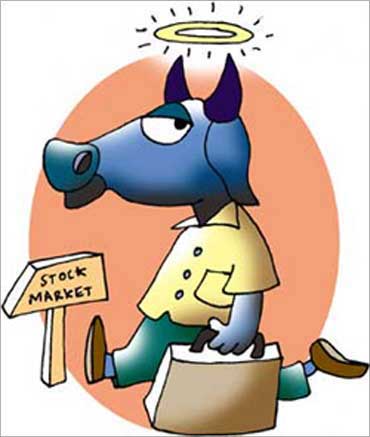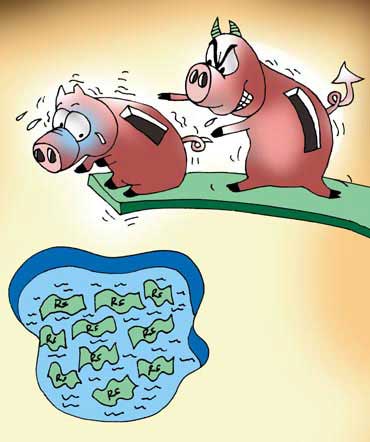Dipta Joshi and Tania Kishore Jaleel in Mumbai
Parag Nayyar's investment in the equity markets has put him in a dilemma. When the news of Koutons' burgeoning debt saw the stock falling, Nayyar sold the share at Rs. 30 a piece, booking losses.
He had purchased it at Rs. 348 a share about a year before.
However, the stock has been moving up on the news of the company going for corporate debt restructuring.
The scrip is trading more than four per cent up at Rs. 38 since the date of announcement of its CDR.
The news of the Koutons CDR has been doing the rounds since March 26.
Nayyar, who sold his entire holding in Koutons a week before the announcement, now thinks he has made a mistake.
How to profit from debt recast
Image: CDR allows companies to restructure loans.The companies that have announced CDR plans during the last year include Kingfisher Airlines, Wockhardt, Vishal Retail and the unlisted Air India.
CDR allows financially troubled companies with multiple lenders and loans of more than Rs 20 crore to restructure those loans and this is construed as good news by the markets.
"The position of the debt of a company should improve after the restructuring. The pressure of interest will reduce and this will definitely improve its financial performance," says V Srinivasan, Senior Director Debt Markets at MAPE Advisory Group.
How to profit from debt recast
Image: In some cases, CDR may involve equity dilution.It could be either due to the overall business scenario like the industry going into recession, which hampers the debt servicing capabilities of a company.
Or, it could be just a case of bad management. For retail investors, the best case is to take an informed decision after coming to know about the exact reasons and terms for CDR.
Restrictions imposed
In some cases, CDR may involve equity dilution by converting the debt into equity.
There could be restrictions on the payout to shareholders, expenses, management salaries and so on.
How to profit from debt recast
Image: Post-CDR, shares can bounce back.For instance, the shares of denim manufacturer, Arvind Ltd, fell to a low of Rs. 9 in the wake of interest defaults in the late 1990s.
Srikanth Desai, who had bought his shares in 1996 at Rs. 113 apiece, was contemplating getting out of them, even at a loss.
However, his broker advised holding on as the company had opted for CDR.
In 2005, Desai exited when the share price touched a high of Rs. 140.
Retail strategy
Retail investors, who have professional help at hand, could remain partially invested to benefit from any possible outcomes post-CDR implementation.
How to profit from debt recast
Image: Uninformed investors should stay away from such stocks.This money could be invested in a better stock, adds Mathew.
Yet others advise uninformed retail investors to stay away from such stocks completely.
Ambareesh Baliga, COO, way2wealth, said: "One needs to see if the company would be able to generate the necessary cash as required to run the business even after the CDR. It is difficult for the retail investor to judge such possibilities."
Typically, most of the companies that are likely to have a successful CDR would be those that have a good asset base and are backed by competent promoters.







article